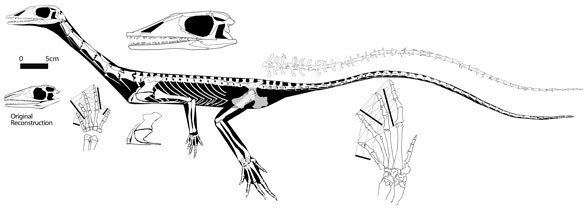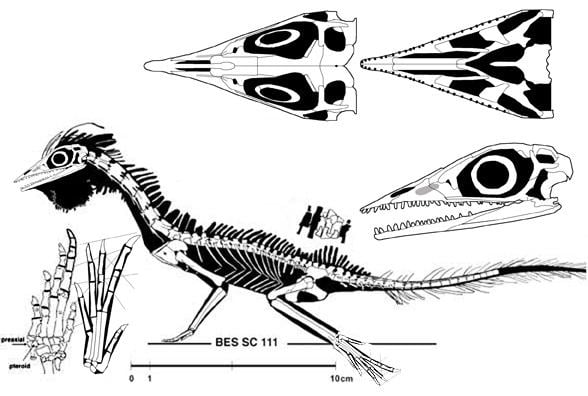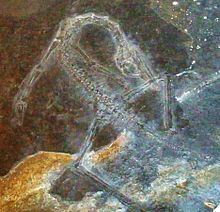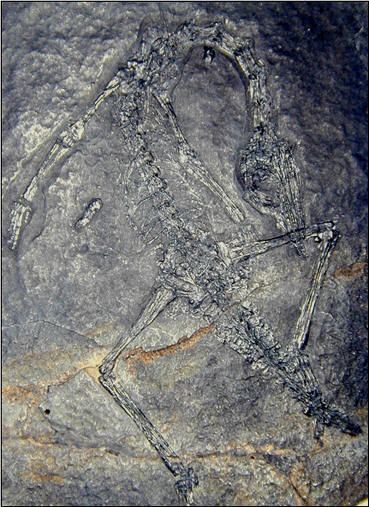Rank Genus | Class Reptilia Phylum Chordata | |
 | ||
Similar Langobardisaurus, Cosesaurus, Protorosauria, Prolacerta, Tanytrachelos | ||
Makpohema macrocnemus bassani nopcsa 43
Macrocnemus is an extinct genus of archosauromorph reptile from the Middle Triassic of Europe and China.
Contents
- Makpohema macrocnemus bassani nopcsa 43
- Introductory Overview
- Description
- Diet
- Geological information
- Historical information
- Species
- References
Introductory Overview

The name is from the Greek for "long tibia". The genus Macrorcnemus is classifed as a Prolacertiformes or Protorosaurus, which has three species. The most abundant species is the Macrocnemus bassanii had many species that ranged in different sizes of morphology and they seem to be 220 myrs old during the Middle Triassic. The size of this species ranged from 20 to 100 centimeters long. The Macrocnemus is believed to be a sister to Huehuecuetzpalli, which is a basal lizard. Also the smallest and most primitive of the Macrocnemus is BES SC 111. Macrocnemus (Reptilia- diapsid) also known as Macrochemus is part of the Tanystropheidae family and have three subtaxa, which include Macrocnemus bassanii, Macrocnemus fuyuanensis and Macrocnemus obristi. Discovered in the Southern Alps from the Besano formation comes a protorosaur Macrocnemus. Nopcsa was the first to describe the Macrochemus based off perseveres of the species that came from Museo Civico di Storia Naturale in Milano. The first species that was named and discovered was the M. bassanii. All the way back to the Middle Triassic of Southern China is a second species of M. fuyuanesis that was discovered,. Then the new species is similar to the one found in Europe and the Chinese diagnosed its characteristics due to the formation of the forelimb. The recently discovered new species of Macrocnemus is the M. obristi , the main features of this species that set it apart from others is that tibia is longer than the femur and it has gracile limbs. The original distal caudal series of the Macrocnemus possesses at least 52 or 53 caudal vertebrae because the newly discovered species M. obristi has it present. Macrornemus is pretty well studied taxa, therefore there is enough evidence to understand the anatomy of the postcranial skeleton. Within the tarsus of the Macrocnemus includes astragalus, calcaneum, a centrale and the distal tarsals 4, 3, 1. A conclusion of based of the appendicular structure of the skeleton implies terrestrial habitats and rapid bipedal movement.
Description

The most primitive M. bassinii, BES SC 111, is believed to arboreal. Its lengthy tendril-like extremities advise experts to conclude that it was a fast climber. There is a trend that favors towards the pelvis anchors to rotate due to the reduction of the caudoferoral retarctor anchors, then the hind limbs to retract. The most prominent feature that distinguishes the Macrocnemus from the Huehuecuetzpalli, is the shorten pedal five digit. What’s odd about that is that nested descendants of Macrocnemus seemed to retain or regain that shorten pedal five digit. This study is further being researched due to insufficient data.
Diet

The Macrocnemus is in the same family as protorosaurus, which are lizards and this this basically the same size as a green iguana. This species is small compared to other predators. Its diet consist of fish, amphibian, insects and when they hunt in packs they go after horseshoe crabs. Macrocnemus is usually on the bottom of the food chain because of its small figure and is also mostly preyed upon by Ticinosuchus.
Geological information

Locations for the collections of the bones of Macrocnemus can be found in the Triassic China, Italy and Switzerland. Features that are common to most protorosaur like Macrocnemus include the ankle having a hooked fifth metatarsal attached to elongated limb elements, with tarsal elements with well-ossified proximal and distal ends.
Historical information

In penecontemporaneous marine sediments only Tanystropheus and Macrocnemus are the known protorosaur generas. Both generas could be differentiated with their pes, which is proximal phalanx. Digit V of the proximal phalanx of the Macrocnemus is shorter then the other digits and with being compared to the Tanystropheus. With the recent discovery of both Macrocnemus and Tanystropheus found in southerwestern China suggest that the faunal of the western and eastern Tethyan realms during the Middle and early Late Triassic are similar. The M. fuyuanesis found in china has a significantly longer humerus than its radius, maybe even more presacral vertebra then M. bassanii and therefore is larger. In 1970 Romer classified Macrocnemus as lepidosaur, but in 1988 Carroll reclassified it under Protorosaurus and Prolacerta.
Species

The species Macrocnemus Obrist was discovered by Christian Obrist during an excavation from the Upper Prosanto Formation, which was in the middle Triassic. It differs from the others because both of the hind legs and the tail are in complete articulation with the posterior region of the dorsal vertebral series. It is noticeably different by its gracile limb elements and having a longer tibia the other two. Also, this species has records of persevered soft tissue in the pelvic gridle. For this newer species of Macrocnemus its tibia is 20% longer then the femur being compare to M.bassanni, also the metatarsal are much more slender.
The species Macrocnemus bassanni was discovered during Ladinia, Middle Triassic. The most primitive form of this species is the BES SC 111 and it is about 30 centimeters long. This species is recorded as a juvenile and according to its phenotypic relationship within the Macrocnemus it is at the base of the clade that includes Tanystropheus, Dinocephalosaurus and Langobardisaurus + Tanytranchelos. Compared to its close relative the Huehuecuetzpalli, its rostrum was more elongated, shorted postorbital, has a quadratojugal process, small numerous close proximal teeth and the maxilla was the same length as the orbit. Another type of M. bassanni is the T4822 and it is 25% larger and has a more gracile temple then the BES SC 111. Other notable features of this type compared to the BES SC 111 include the shorter and more robust cervicals, narrower pubis, and the third pedal digit is longer then the IV and V.
The species Macrocnemus fuyuanesis was discovered at the Yunnan Province, southwestern China from the marine of the Triassic. More specially, it was in the Zhugnapo Member of the Falang Formation. The main features that set this species apart from the M. bassanii include 17 or 18 dorsal vertebrae, the humerus being lengthy and also the femur is longer than the tibia. Clear preorbital difference can be seen in the skull compared to M. bassanii. According to Olivier Riepple et. al “A large, plate-like lacrimal is located in front of the tall, columnar prefrontal that defines the anterior margin of the orbit. A longitudinally oriented nasal groove extends along the anterior two-thirds of the snout, accommodating the external naris at its anterior part”. The contrasting feature of the M. fuyuanesis to the M. bassanii is its humerus being more elongated then its radius.
